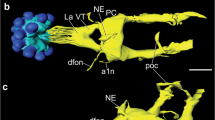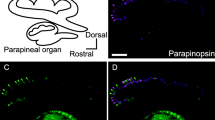Summary
The pineal organ (epiphysis cerebri) of Pterophyllum scalare is formed by neuronal and glial elements. Ependymal supportive cells are very abundant, and their cytoplasmic processes envelop adjacent receptor cells and unmyelinated nerve fibers by an intertwining network. In addition to this type of neuroglia, oligodendrocytic cells have also been identified. The receptor cells show the general structural pattern (outer segment, inner segment, basal process) of teleostean pineal receptors. The ciliary part of the outer segment bears a dome-like stack of 50–70 curved saccules each of average length of 6 μm. In the basal part of the receptor cell, slender mitochondria containing irregular cristae and tubules, and also some more spherical mitochondria with a highly regular arrangement of cristae, can be observed. The basal cytoplasmic process radiates into neuropile-like areas that contain axial bundles of axons. Synaptoid contacts rarely occur. The number of unmyelinated axons of the pineal stalk, increases in a proximad direction (towards the brain). This finding has been verified in partial reconstructions. In the transitional zone leading from the pineal body into the pineal stalk, a few myelinated fibers become visible. With respect to cell types and the axonic bundles of the pineal stalk in Pterophyllum scalare, more detailed data are presented than for most other teleostean pineal organs examined thus far. The comparison of pineal sensory cells in several fishes allows a distinction among three different types of outer segments, i.e., a slender type, a dome-like type, and a cap-like type. These structural types are discussed with respect to the relevant physiological results. The existence of particular structural types of the outer segment does not explain the different electrophysiological reactions observed in different pineal organs.
Zusammenfassung
Das Pinealorgan (Epiphysis cerebri) des Knochenfisches Pterophyllum scalare besteht aus nervösen und gliösen Zellelementen. Sehr stark ausgebildet sind die ependymalen Stützzellen. Sie umhüllen mit ihren Ausläufern, die sich überlappen können, andere Zellelemente, z.B. Rezeptorzellen und marklose Nervenfasern. Neben dieser Neuroglia-Art finden sich auch noch oligodendrocytenähnliche Gliazellen. In ihrer Grundstruktur entsprechen die Rezeptoren den Epiphysensinneszellen anderer Knochenfische. Vom cilientragenden Teil des Außenglieds geht ein schürzenartiger Lamellenstapel aus. Dieser besteht aus 50–70 Lamellenplatten von etwa 6 μm Länge. Im basalen Teil der Rezeptorzelle sind neben schlanken Mitochondrien mit unregelmäßigen Cristae und Tubuli auch noch große, runde Mitochondrien mit einer regelmäßigen Cristastruktur zu beobachten. Der basale Fortsatz der Rezeptorzelle ist auf die axial verlaufenden Axonbündel ausgerichtet. Synapsenartige Kontakte sind selten. Die Zahl der marklosen Axone nimmt hirnwärts zu; dieser Befund wurde in partiellen Rekonstruktionen gesichert. Am Übergang in den Epiphysenstiel treten einige markhaltige Axone auf. Zur Verteilung der Zelltypen und zum Verlauf der Axonbündel im Epiphysenstiel des Skalars liegen detailliertere Angaben vor als bei anderen bisher untersuchten Knochenfischepiphysen. In der Diskussion werden nach Vergleich der pinealen Rezeptoren verschiedener Fische drei Außengliedformen unterschieden: Bürsten-, Schürzen- und Kappentyp. Diese Varianten werden in Verbindung mit den bekannten physiologischen Reaktionsformen der Pinealorgane diskutiert. Die elektrophysio logischen Unterschiede lassen sich nicht mit verschiedenen Strukturtypen des Außenglieds erklären.
Similar content being viewed by others
Literatur
Altner, H.: Histologische und histochemische Untersuchungen an der Epiphyse von Haien. Progr. Brain Res. 10, 104–171 (1965).
Bergmann, H.-H.: Eine deskriptive Verhaltensanalyse des Segelflossers (Pterophyllum scalare CUV. et VAL., Cichlidae, Pisces). Z. Tierpsychol. 25, 559–587 (1968).
- Untersuchungen zur Verhaltensentwicklung beim Segelflosser (Pterophyllum scalare CUV. et VAL., Cichlidae). Z. Tierpsychol. (im Druck, 1971).
Blüm, V.: Die Auslösung des Laichreflexes durch Reserpin bei dem südamerikanischen Buntbarsch Pterophyllum scalare. Z. vergl. Physiol. 60, 79–81 (1968a).
—: Experimente zum Steuerungsmechanismus hormoninduzierter Brutpflegereaktionen beim Buntbarsch Pterophyllum scalare. Z. vergl. Physiol. 61, 21–33 (1968b).
—, Fiedler, K.: Hormonal control of reproductive behavior in some cichlid fish. Gen. comp. Endocr. 5, 186–196 (1965).
Breucker, H., Horstmann, E.: Elektronenmikroskopische Untersuchungen am Pinealorgan der Regenbogenforelle (Salmo irideus). Progr. Brain Res. 10, 259–269 (1965).
Collin, J.-P.: La cupule sensorielle de l' organe pinéal de la lamproie de Planer. Arch. Anat. micr. Morph. exp. 58, 145–182 (1969a).
—: Contribution a l'étude de l'organe pinéal. Ann. Stat. Biol. de Besse-en-Chandesse, Suppl. 1, 1–539 (1969b).
Dodt, E.: Photosensitivity of the pineal organ in the teleost, Salmo irideus (Gibbons). Experientia (Basel) 19, 642 (1963).
—: Vergleichende Physiologie der lichtempfindlichen Wirbeltier-Epiphyse. Nova Acta Leopoldina, N.F. 31, 219–235 (1966).
- Das „dritte“ Auge beim Grasfrosch. Umschau H. 2, 54 (1968).
—, Heerd, E.: Mode of action of pineal nerve fibers in frogs. J. Neurophysiol. 25, 405–429 (1962).
—, Jacobson, M.: Photosensitivity of a localized region of the frog diencephalon. J. Neurophysiol. 26, 752–758 (1963).
—, Morita, Y.: Purkinje-Verschiebung, absolute Schwelle und adaptives Verhalten einzelner Elemente der intrakranialen Anuren-Epiphyse. Vision Res. 4, 413–421 (1964).
—: Conduction of nerve impulses within the pineal system of frog. Pflügers Arch. ges. Physiol. 293, 184–192 (1967).
- Ueck, M., Oksche, A.: Relations of structure and function: The pineal organ of lower vertebrates. J.E. Purkyně Centenary Symposion, V. Kruta (ed.) Prague, 8.–10. 9. 1969 (Im Druck).
Eakin, R. M.: Photoreceptors in the amphibian frontal organ. Proc. nat. Acad. Sci. (Wash.) 47, 1084–1088 (1961).
—, Quay, W. B., Westfall, J.: Cytological and cytochemical studies on the frontal and pineal organs of the treefrog, Hyla regilla. Z. Zellforsch. 59, 663–683 (1963).
—, Westfall, J.: The development of photoreceptors in the stirnorgan of the treefrog, Hyla regilla. Embryologia (Nagoya) 6, 84–98 (1961).
Farquhar, M. G., Palade, G. E.: Junctional complexes in various epithelia. J. Cell Biol. 17, 375–412 (1963).
Fawcett, D. W.: An atlas of fine structure. The cell. Philadelphia and London: W. B. Saunders Co. 1966.
Fenwick, J. C.: Demonstration and effect of melatonin in fish. Gen. comp. Endocr. 14, 86–97 (1970a).
—: The pineal organ: Photoperiod and reproductive cycles in the goldfish, Carassius auratus L. J. Endocr. 46, 101–111 (1970b).
—: Effects of pinealectomy and bilateral enucleation on the phototactic response and on the conditioned response to light of the goldfish Carassius auratus L. Canad. J. Zool. 48, 175–182 (1970c).
Hamasaki, D. I., Dodt, E.: Light sensitivity of the lizard's epiphygis cerebri. Pflügers Arch. 313, 19–29 (1969).
—, Streck, P.: Properties of the epiphysis cerebri of the small-spotted dogfish shark, Scyliorhinus caniculus L. Vision Res. 11, 189–198 (1971).
Hanyu, J., Niwa, H., Tamura, T.: A slow potential from the epiphysis cerebri of fishes. Vision Res. 9, 621–623 (1959).
Holmgren, N.: Zur Kenntnis der Parietalorgane von Rana temporaria. Ark. Zool. 11, 1–13 (1918).
Holmgren, U.: On the structure of the pineal area of teleost fishes. With special reference to a few deep sea fishes. Göteborgs Kgl. Vetenskaps-Vitterhets-Samhäll. Handl., Ser. B 8, No 3, 5–66 (1959).
Miller, P. H., Wolbarsht, M. L.: Neural activity in the parietal eye of the lizard. Science 135, 316–317 (1962).
Missotten, L.: The ultrastructure of the human retina. Brüssel: Ed. Arscia 1965.
Morita, Y.: Extra- und intracelluläre Ableitungen einzelner Elemente des lichtempfindlichen Zwischenhirns anurer Amphibien. Pflügers Arch. ges. Physiol. 286, 97–108 (1965).
—: Entladungsmuster pinealer Neurone der Regenbogenforelle (Salmo irideus) bei Belichtung des Zwischenhirns. Pflügers Arch. ges. Physiol. 289, 155–167 (1966).
- Dodt, E.: Photosensory responses from the pineal eye of the lamprey (Petromyzon fluviatilis). Abstr. of Comm. XXV. Intern. Physiol. Congr. München (1971).
Nilsson, S. E. G., Crescitelli, F.: A correlation of ultrastructure and function in the developing retina of the frog tadpole. J. Ultrastruct. Res. 30, 87–102 (1970).
Oksche, A.: Survey of the development and comparative morphology of the pineal organ. Progr. Brain Res. 10, 3–29 (1965).
—, Harnack, M. von: Elektronenmikroskopische Untersuchungen am Stirnorgan von Anuren (Zur Frage der Lichtrezeptoren). Z. Zellforsch. 59, 239–288 (1963).
—, Kirschstein, H.: Elektronenmikroskopische Feinstruktur der Sinneszellen im Pinealorgan von Phoxinus laevis L. (Pisces, Teleostei, Cyprinidae). Naturwissenschaften 53, 591 (1966).
—: Die Ultrastruktur der Sinneszellen im Pinealorgan von Phoxinus laevis L. Z. Zellforsch. 78, 151–166 (1967).
—: Unterschiedlicher elektronenmikroskopischer Feinbau der Sinneszellen im Parietalauge und im Pinealorgan (Epiphysis cerebri) der Lacertilia. Z. Zellforsch. 87, 159–192 (1968).
—: Elektronenmikroskopische Untersuchungen am Pinealorgan von Passer domesticus. Z. Zellforsch. 102, 214–241 (1969).
—: Weitere elektronenmikroskopische Untersuchungen am Pinealorgan von Phoxinus laevis L. (Teleostei, Cyprinidae). Z. Zellforsch. 112, 572–588 (1971).
—, Vaupel-von Harnack, M.: Elektronenmikroskopische Untersuchungen an der Epiphysis cerebri von Rana esculenta L. Z. Zellforsch. 59, 582–614 (1963).
—: Die elektronenmikroskopische Feinstruktur des Stirnorgans (Epiphysenendblase) der Anuren. Progr. Brain Res. 5, 209–222 (1964).
—: Vergleichende elektronenmikroskopische Studien am Pinealorgan. Progr. Brain Res. 10, 237–258 (1965).
Omura, Y., Kitoh, J., Oguri, M.: The photoreceptor cells of the pineal organ of the Ayu, Plecoglossus altivelis. Bull. Jap. Soc. Sci. Fisheries 35, 1067–1071 (1969).
—, Oguri, M.: Histological studies on the pineal organ of 15 species of teleosts. Bull. Jap. Soc. Sci. Fisheries 35, 991–1000 (1969).
Owman, C., Rüdeberg, C.: Light, fluorescence, and electron microscopic studies on the pineal organ of the pike, Esox lucius L., with special regard to 5-hydroxytryptamine. Z. Zellforsch. 107, 522–550 (1970).
Paul, E., Hartwig, H.-G., Oksche, A.: Neurone und zentralnervöse Verbindungen des Pinealorgans der Anuren. Z. Zellforsch. 112, 466–493 (1971).
Petit, A.: Ultrastructure de la rétine de l'oeil pariétal d'un Lacertilien, Anguis fragilis. Z. Zellforsch. 92, 70–93 (1968).
—: Ultrastructure, innervation et fonction de l'epiphyse de l'Orvet (Anguis fragilis). Z. Zellforsch. 96, 437–465 (1969).
Rüdeberg, C.: Electron microscopical observations on the pineal organ of the teleosts Mugil auratus (Risso) and Uranoscopus scaber (Linne). Pubbl. Staz. zool. Napoli 35, 47–60 (1966).
—: A rapid method for staining thin sections of Vestopal W-embedded tissue for light microscopy. Experientia (Basel) 23, 792 (1967).
—: Structure of the pineal organ of the sardine, Sardina pilchardus (Risso), and some further remarks on the pineal organ of Mugil spp. Z. Zellforsch. 84, 219–237 (1968a).
—: Receptor cells in the pineal organ of the dogfish, Scyliorhinus canicula Linné. Z. Zellforsch. 85, 521–526 (1968b).
—: Structure of the parapineal organ of the adult rainbow trout, Salmo gairdneri Richardson. Z. Zellforsch. 93, 282–304 (1969a).
—: Light and electron microscopic studies on the pineal organ of the dogfish, Scyliorhinus canicula L. Zellforsch. 96, 548–581 (1969b).
Takahashi, H.: Light and electron microscopic studies on the pineal organ of the goldfish, Carassius auratus L. Bull. Fac. Fisheries Hokkaido Univ. 20, 143–157 (1969).
The, G. de: Cytoplasmic microtubules in different animal cells. J. Cell Biol. 23, 265–276 (1964).
Ueck, M.: Ultrastruktur des pinealen Sinnesapparates bei einigen Pipidae und Discoglossidae. Z. Zellforsch. 92, 452–476 (1968).
—: Ultrastrukturbesonderheiten der pinealen Sinneszellen von Protopterus dolloi. Z. Zellforsch. 100, 560–580 (1969).
Vivien-Roels, B.: Etude structurale et ultrastructurale de l'épiphyse d'un reptile: Pseudemys scripta elegans. Z. Zellforsch. 94, 352–390 (1969).
—: Ultrastructure, innervation et fonction de l'épiphyse chez les Chéloniens. Z. Zellforsch. 104, 429–448 (1970).
Wartenberg, H., Baumgarten, H. G.: Elektronenmikroskopische Untersuchungen zur Frage der photosensorischen und sekretorischen Funktion des Pinealorgans von Lacerta viridis und L. muralis. Z. Anat. Entwickl.-Gesch. 127, 99–120 (1968).
—, Gusek, W.: Licht- und elektronenmikroskopische Beobachtungen über die Struktur der Epiphysis cerebri des Kaninchens. Progr. Brain Res. 10, 296–316 (1965).
Zimmermann, P.: Struktur, Verteilung und Funktion der Kontaktzonen im Bauchmark von Lumbricus terrestris L. Z. Zellforsch. 87, 137–158 (1968).
Author information
Authors and Affiliations
Additional information
Mit Unterstützung durch die Deutsche Forschungsgemeinschaft (Arbeitskreise A. Oksche und E. Dodt).
Für die Überlassung des Tiermaterials und vielerlei Unterstützung danke ich Herrn Dr. H.-H. Bergmann, Zoologisches Institut der Universität, Marburg a. d. Lahn, für technische Hilfe Frau R. Schneider (lichtmikroskopische Technik) und Frl. D. Vaihinger (Ausführung der Zeichnungen), Gießen.
Ein Druckkostenzuschuß wurde von beiden Instituten zur Verfügung gestellt.
Rights and permissions
About this article
Cite this article
Bergmann, G. Elektronenmikroskopische Untersuchungen am Pinealorgan von Pterophyllum scalare Cuv. et Val. (Cichlidae, Teleostei). Z. Zellforsch. 119, 257–288 (1971). https://doi.org/10.1007/BF00324525
Received:
Issue Date:
DOI: https://doi.org/10.1007/BF00324525




